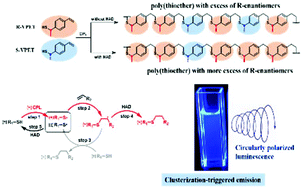Improved enantioselectivity in thiol–ene photopolymerization of sulphur-containing polymers with circularly polarized luminescence†
Abstract
Circularly polarized light (CPL)-triggered enantioselective thiol–ene reactions, which combine absolute asymmetric synthesis with click reactions, enable facile synthesis of optically active poly(thioether) directly from a racemic monomer. However, the enantioselectivity is low and the challenge of producing highly asymmetrical poly(thioether) with distinct circularly polarized luminescence has not been met to date. Herein, we show that the poor enantioselectivity can be largely attributed to the inevitable racemization of thiyl radicals during the growth cycle, and more importantly, it can be remedied by addition of achiral hydrogen atom donors (HAD). The enhancement in enantioselectivity of CPL-triggered thiol–ene reactions can be experimentally controlled by varying the reaction kinetics without introducing any chiral inducer other than CPL. A maximum excess of enantiomeric units (∼20%) in the final polymer chains could be obtained, and so-formed optically active poly(thioether) exhibited not only clusterization-triggered emission (CTE), but also fascinating circularly polarized luminescence for the first time.



 Please wait while we load your content...
Please wait while we load your content...